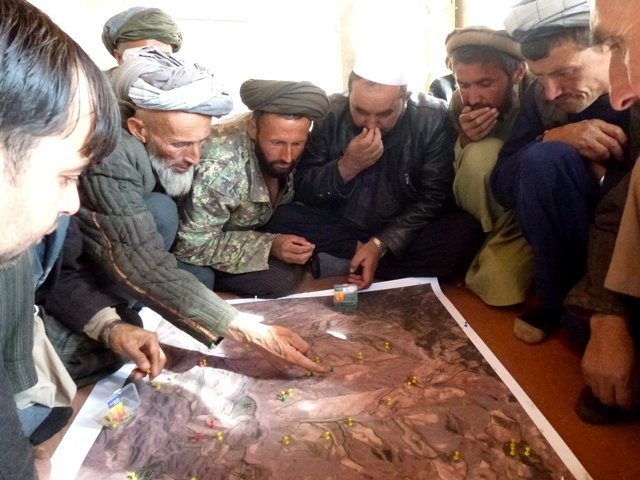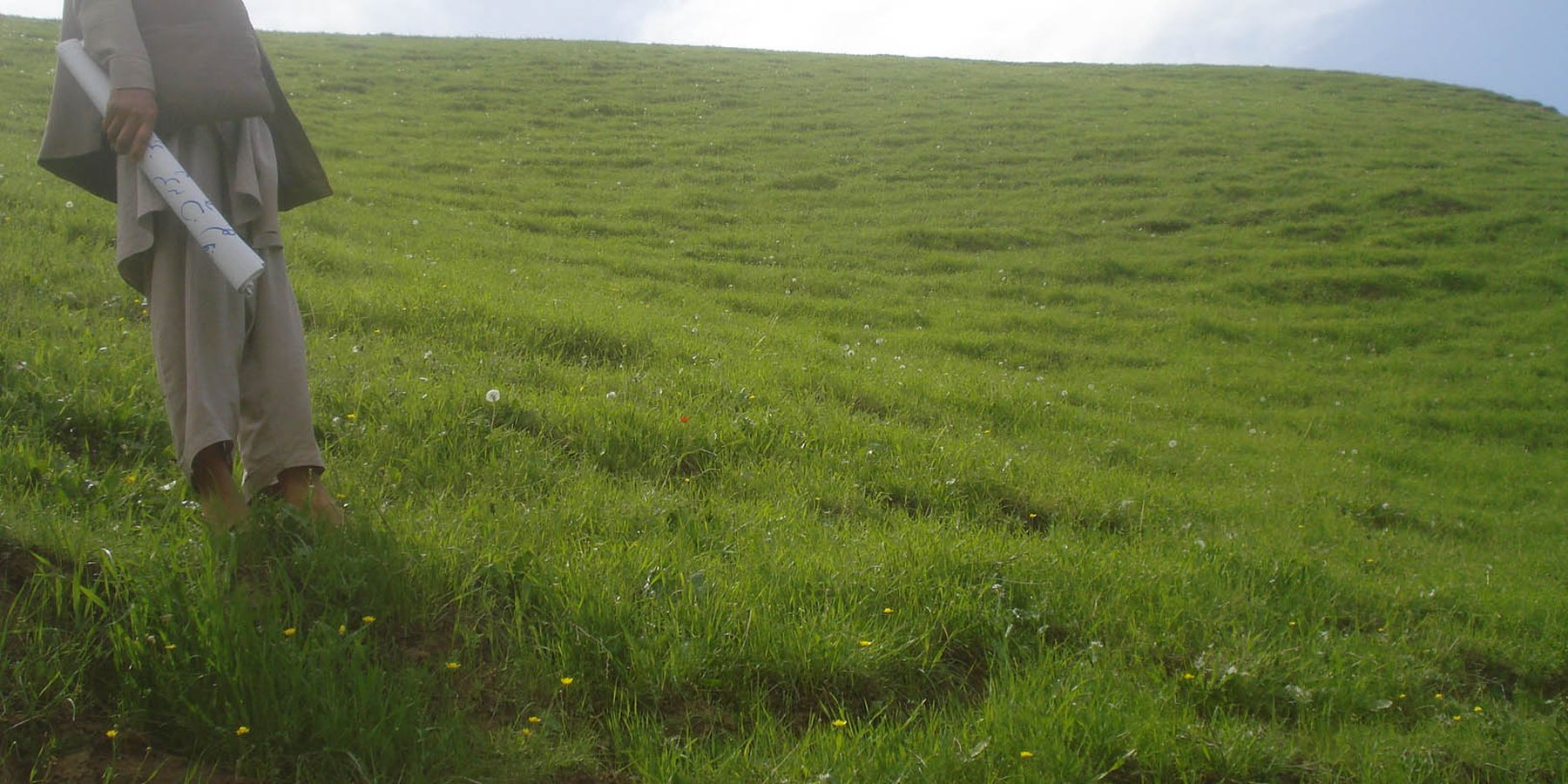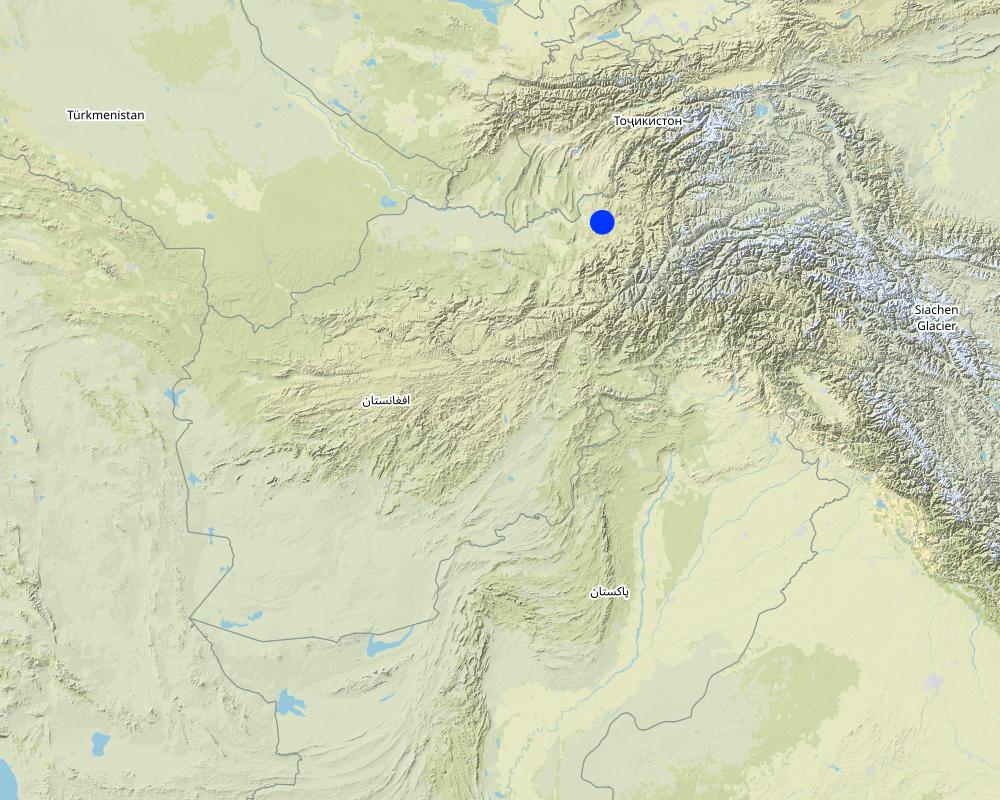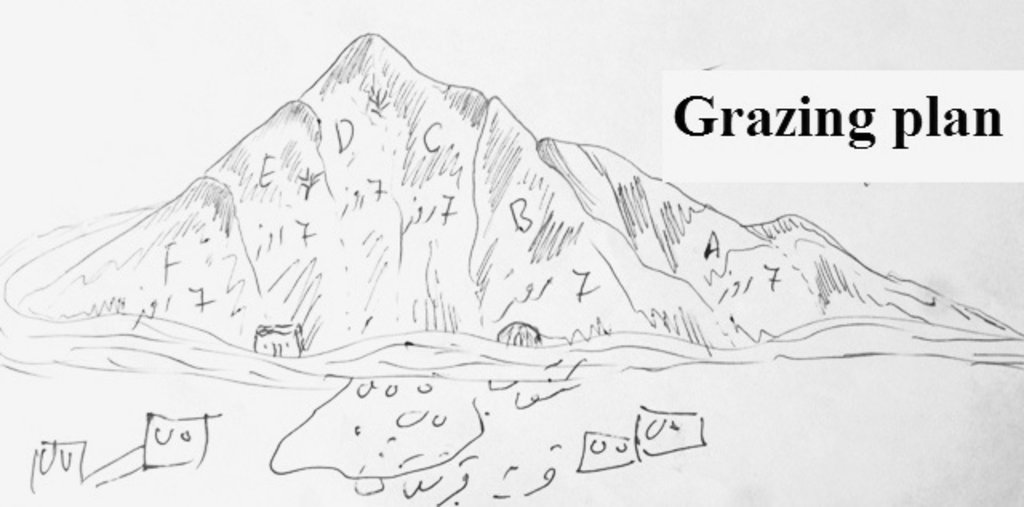Rotational grazing to restore degraded pastures [Афганистан]
- Создание:
- Обновить:
- Составитель: Bettina Wolfgramm
- Редакторы: MIAJAN MAROOFI, Hekmatullah Sharifzai, Roziya Kirgizbekova, Aslam Qadamov
- Рецензент: William Critchley
Ploni ba navbat charonidani mol ba khotiri behbudi charogoh
technologies_671 - Афганистан
Просмотреть разделы
Развернуть все Свернуть все1. Общая информация
1.2 Контактные данные специалистов и организаций, участвующих в описании и оценке Технологии
Специалист по УЗП:
Researcher:
Название проекта, содействовавшего документированию/оценке Технологии (если применимо)
Livelihood Improvement Project Takhar, Afghanistan (LIPT)Название проекта, содействовавшего документированию/оценке Технологии (если применимо)
Potential and limitations for improved natural resource management (NRM) in mountain communities in the Rustaq district, Afghanistan (Rustaq NRM Study)Название организации (-ий), содействовавших документированию/оценке Технологии (если применимо)
Terre des Hommes (Terre des Hommes) - ШвейцарияНазвание организации (-ий), содействовавших документированию/оценке Технологии (если применимо)
Swiss Agency for Development and Cooperation (DEZA / COSUDE / DDC / SDC) - ШвейцарияНазвание организации (-ий), содействовавших документированию/оценке Технологии (если применимо)
CDE Centre for Development and Environment (CDE Centre for Development and Environment) - Швейцария1.3 Условия, регламентирующие использование данных, собранных ВОКАТ
Когда были собраны данные (на местах)?
17/10/2016
Составитель и ответственный(-ые) специалист(-ы) согласны с условиями, регламентирующими использование собранных ВОКАТ данных:
Да
1.4 Декларация по устойчивости описываемой Технологии
Вызывает ли описанная здесь Технология проблемы деградации земель настолько, что ее нельзя назвать природосберегающей?
Нет
1.5 Ссылка на Анкету (-ы) по Подходам УЗП

Watershed Associations (WSA) and Natural Resource Management Committees … [Афганистан]
Two Watershed Associations (WSA), in Chaker and Nahristan watershed areas respectively, are registered at the national level with the Ministry of Agriculture Irrigation and Livestock (MAIL) and at the regional level with the Department of Agriculture. Both associations are strong, active, dynamic, and have the capacity to coordinate and support …
- Составитель: Bettina Wolfgramm
2. Описание Технологии УЗП
2.1 Краткое описание Технологии
Определение Технологии:
A plan for rotational grazing has been developed to control pasture use and prevent overgrazing of rehabilitated pastures.
2.2 Подробное описание Технологии
Описание:
Livestock keeping is one of the key livelihood strategies in rural Rustaq, in addition to cultivation of cereals. Families rely on their livestock not only for consumption of meat from cattle, goats and sheep, and dairy products such as milk and sour milk, but also as means of transportation (donkeys), labour in agriculture (oxen, donkeys) and as a source of income through sales. Naturally, every family strives to increase their household’s livestock as much as they can, which increases the pressure on the local pastures - leading to extensive overgrazing. The pastures in Jawaz Khana and Sari Joy are characterized by poor vegetation cover, low carrying capacity and severe erosion with deep rills clearly visible. Heavy rains in spring and autumn wash off the topsoil on pastures, resulting in heavy erosion, landslides and gully formation. These severely degraded pastures continue to be used though "open access" - without any management schemes or regulations in place. Some pastures that are not suitable for grazing have been converted to arable lands and tree plantations. The quantity and quality of livestock fodder is insufficient for all the livestock, and this affects animal health.
Plans for rotational grazing were prepared for the communities in Sari Joy and Jawaz Khana to organize the use of local pastures and prevent their further degradation. Rotational grazing plans regulate the frequency and intensity of livestock grazing on the pastures. The area is seeded with alfalfa to improve the fodder stock and enhance the quality of the pasture. For up to three years the seeded area is closed to grazing, during which period the community is provided with stocks of hay and straw to feed their livestock as an alternative. After the end of the closure period, the grazing area is divided into 6-7 sections (paddocks) depending on the area of the pasture. The livestock graze the first paddock for 7 days and move to the next paddock. Each paddock is grazed for the period of 7 days during April and May. From the month of May the grazing area is closed for resting. The livestock move to the summer pastures for the rest of the summer months.
The community is key in preparing the grazing plans and identifying the pastures where these plans will be applied, as well as the conditions which are part of it, such as the frequency of the grazing period. Frequent meetings need to be held with the community livestock holders to explain the purpose of the rotational grazing and how it can be beneficial in pasture improvement. The Natural Resources Management Committee and the technical staff of the Livelihood Improvement Project (LIPT) are in charge of engaging the local pasture users to meet their needs and consider their views accordingly.
The actual implementation of the rotational grazing plans is difficult to assess for the time being. The grazing area is not fully restored and the fodder stock remains low. Many land users do not fully understand the concept behind the rotational grazing plans or their purpose. In an area where there is a severe shortage of livestock fodder and very limited grazing land, accepting and following these plans will require more time and additional support in terms of awareness-raising and support feeding of the livestock during the exclusion period. The villagers have some doubts about the costs and benefits of grazing and rotation. They have no full understanding of the benefits of the rotational grazing for their household and are likely to be not ready to adhere to such schemes.
Women are part of the livestock management system, and are in charge of feeding and taking care of the livestock. However, they are not aware about the plans for rotational grazing in their village and how are these plans are applied in practice.
2.3 Фотографии, иллюстрирующие Технологию
2.5 Страна/ регион/ места, где применяется Технология, информация о которых собрана в данной Анкете
Страна:
Афганистан
Административная единица (Район/Область):
Takhar Province, Rustaq District
Более точная привязка места:
Sari Joy and Jawaz Khana Villages
Map
×2.6 Сколько лет применяется данная Технология
Год начала реализации:
2015
Если год начала применения Технологии достоверно неизвестен, дайте примерную оценку:
- менее 10 лет назад (недавняя)
2.7 Внедрение Технологии
Укажите, как именно Технология УЗП была внедрена:
- через проекты/ внешнее вмешательство
Пояснения (тип проекта и т.д.):
Livelihood Improvement Project in Takhar (LIPT) implemented by Terre des hommes (Tdh) Switzerland
3. Классификация Технологии УЗП
3.1 Основные цели и задачи реализации Технологии
- повышение производства
- снижение или предотвращение деградации земель, восстановление нарушенных земель
3.2 Текущий(-ие) тип(-ы) землепользования на территории, где применяется Технология

Пастбищные угодья
Пастбищные земли, экстенсивный выпас:
- Полукочевое/ отгонное животноводство
Интенсивный выпас/ выращивание кормов:
- Улучшенные пастбища
Основные породы скота и виды продукции:
Cow, Sheep, Goat. Alfalfa
Если использование земель изменилось с началом применения Технологии, укажите тип землепользования до применения Технологии:
Some areas under the Technology are former croplands, which have been completely degraded and no longer suitable for crop cultivation.
3.3 Дополнительная информация о землепользовании
Обеспеченность водой участков, где реализуется Технология :
- богарные земли
Число урожаев за год:
- 1
3.4 Категория УЗП, к которой относится Технология
- Кочевое животноводство и пастбищное хозяйство
3.5 Распределение Технологии по площади
Охарактеризуйте пространственное распространение Технологии :
- равномерно-однородное применение на определенной площади
Если Технология равномерно применяется на той или иной территории, укажите ее приблизительную общую площадь:
- 0,1-1 км2
Пояснения:
6 ha
3.6 Мероприятия УЗП, выполняемые в рамках Технологии

управленческие мероприятия
- У2: Изменение формы/ интенсивности хозяйствования
3.7 Основные проблемы деградации земель, на решение которых направлена Технология

водная эрозия почв
- ВЭп: поверхностная эрозия/смыв верхних почвенных горизонтов

ветровая эрозия почв
- Эп: утрата плодородного слоя почвы

ухудшение физических свойств почв
- Фу: уплотнение

биологическая деградация
- Бр: сокращение растительного покрова
- Бк: сокращение количества биомассы

другое
3.8 Предотвращение и снижение деградации земель, или восстановление нарушенных земель
Укажите цель Технологии по отношению к деградации земель :
- восстановление/ реабилитация нарушенных земель
4. Технические характеристики, мероприятия по практической реализации, вложения и стоимость
4.1 Технический рисунок, иллюстрирующий Технологию
4.2 Спецификация / пояснения к техническому рисунку
After the end of the exclusion period the grazing area is divided into 6-7 sections (paddocks) depending on the area of the pasture. The livestock graze the first paddock for 7 days and move to the next paddock after 7 days. Each paddock is grazed for the period of 7 days during April and May. From the month of May the grazing area is closed for resting. The livestock move to the summer pastures for the rest of the summer months.
4.3 Общая информация по необходимым вложениям и стоимости
Уточните, как рассчитывались затраты и вложения:
- на площадь, где применяется Технология
Укажите размер и единицу площади:
1 ha
Укажите денежные единицы, использованные для подсчета затрат:
- Доллары США
Укажите обменный курс между долларом США и местной валютой (если уместно): 1 доллар США =:
67,0
Укажите среднюю дневную заработную плату наемных работников:
5.2-5.3 USD
4.4 Мероприятия, необходимые для начала реализации
| Деятельность | Тип мероприятия | Сроки | |
|---|---|---|---|
| 1. | Selection of the pasture area and awareness raising among people | Управленческие | Fall |
| 2. | Leveling of the land | Агрономические | Fall |
| 3. | Sowing alfalfa seed | Агрономические | Spring |
| 4. | Site under quarantine | Управленческие | Three years |
| 5. | Preparation of the grazing plan and community meetings | Управленческие | Fall |
| 6. | Protection of the site during quarantine | Управленческие | Three years |
4.5 Вложения и затраты, необходимые для начала реализации
| Опишите затраты | Единица | Количество | Затраты на единицу | Общая стоимость на единицу | % затрат, оплаченных землепользователями | |
|---|---|---|---|---|---|---|
| Оплата труда | Leveling the land with a rake | person-day | 150,0 | 5,3 | 795,0 | 71,0 |
| Оплата труда | Sowing alfalfa | person-day | 5,0 | 5,3 | 26,5 | 71,0 |
| Оплата труда | Preparation of grazing plan | person-day | 2,0 | 9,0 | 18,0 | |
| Оплата труда | Protection of the site | year | 1,0 | 447,0 | 447,0 | 100,0 |
| Оборудование | Shovel | piece | 1,0 | 3,8 | 3,8 | 100,0 |
| Оборудование | Rope | Meter | 50,0 | 0,15 | 7,5 | 100,0 |
| Оборудование | Rake | piece | 1,0 | 3,0 | 3,0 | 100,0 |
| Посадочный материал | Alfalfa seed | kg | 17,5 | 0,42 | 7,35 | |
| Удобрения и ядохимикаты | DAP | kg | 125,0 | 0,9 | 112,5 | |
| Удобрения и ядохимикаты | Urea | kg | 125,0 | 0,45 | 56,25 | |
| Общая стоимость запуска Технологии | 1476,9 | |||||
Если землепользователем оплачено менее 100% затрат, укажите, кем покрывались остальные затраты:
Livelihood Improvement Project Takhar (LIPT) implemented by Terre des hommes (Tdh) Switzerland
4.6 Поддержание/ текущее обслуживание
| Деятельность | Тип мероприятия | Сроки/ повторяемость проведения | |
|---|---|---|---|
| 1. | Community agrees to leave the pasture for resting/ exclusion | Управленческие | Three years |
| 2. | Rotational grazing | Другие мероприятия | Spring/week/grazing plot |
| 3. | Reseeding alfalfa | Мероприятия с использованием растительности | After 5 years |
| 4. | Protection of the site | Управленческие | Three years |
4.7 Стоимость поддержания/ текущего обслуживания ( в год)
| Опишите затраты | Единица | Количество | Затраты на единицу | Общая стоимость на единицу | % затрат, оплаченных землепользователями | |
|---|---|---|---|---|---|---|
| Оплата труда | Reseeding alfalfa | person day | 5,0 | 5,3 | 26,5 | 100,0 |
| Оплата труда | Protection during exclusion | year | 2,0 | 447,0 | 894,0 | 100,0 |
| Посадочный материал | Alfalfa seed | kg | 17,5 | 0,42 | 7,35 | 100,0 |
| Общая стоимость поддержания Технологии | 927,85 | |||||
Пояснения:
Costs calculated for a Technology area of 1ha was only done for the purpose of the WOCAT documentation. In reality SLM plots are on average 0.4 ha or 2 jiribs. Costs were simply multiplied by 2.5. The actual costs for a 1ha plot might be slightly different.
4.8 Наиболее значимые факторы, влияющие на стоимость затрат
Опишите наиболее значимые факторы, влияющие на стоимость затрат:
Due to the remoteness of the villages where the technology has been implemented, all the inputs for establishment, such as agricultural equipment, plant material, fertilizers, etc., are purchased in Rustaq town. The expenses for traveling and delivering the inputs affect the establishment costs.
5. Природные и социально-экономические условия
5.1 Климат
Среднегодовое количество осадков
- < 250 мм
- 251-500 мм
- 501-750 мм
- 751-1000 мм
- 1001-1500 мм
- 1501-2000 мм
- 2001-3000 мм
- 3001-4000 мм
- > 4000 мм
Пояснения/ комментарии по осадкам:
Average annual precipitation for the area was calculated with 580 mm, with minimum in dry years (2000 and 2001) of 270 mm and maximum in wet years (2009/2010) of 830 mm. The absolute maximum rainfall was calculated for 1986 with 1024 mm. The data series covers the period from 1979 to 2014.
Агроклиматическая зона
- полузасушливая
5.2 Рельеф
Склоны (преобладающие):
- пологие (0-2%)
- покатые (3-5%)
- покато-крутые (6-10%)
- крутые (11-15%)
- очень крутые (16-30%)
- чрезвычайно крутые (31-60%)
- обрывистые (>60%)
Формы рельефа:
- плато/ равнины
- гребни хребтов/холмов
- склоны гор
- склоны холмов
- подножья
- днища долин
Зона высотной поясности:
- 0-100 м над уровнем моря
- 101-500 м н.у.м.
- 501-1000 м н.у.м.
- 1001-1500 м н.у.м.
- 1501-2000 м н.у.м.
- 2001-2500 м н.у.м.
- 2501-3000 м н.у.м.
- 3001-4000 м н.у.м.
- > 4 тыс. м н.у.м.
5.3 Почвы
Средняя мощность почв:
- поверхностные (0-20 см)
- неглубокие (21-50 см)
- умеренно глубокие (51-80 см)
- глубокие (81-120 см)
- очень глубокие (> 120 см)
Гранулометрический состав (верхнего горизонта):
- средние фракции (суглинистый, супесчаный)
Гранулометрический состав (на глубине более 20 см):
- грубый крупнозернистый/ лёгкий (песчаный)
- средние фракции (суглинистый, супесчаный)
Содержание органического вещества в верхнем горизонте:
- низкое (< 1%)
Если возможно, приложите полное описание почв или укажите доступную информацию, например тип почв, рH/ кислотность почв, ёмкость катионного обмена, содержание азота, содержание солей и т.д.
Local land users differentiate between the following soil types where the technology is implemented:
- Red: shallow; texture medium, coarse; low organic matter
- Light: moderately deep; texture medium; medium, low organic matter
5.4 Доступность и качество воды
Уровень грунтовых вод:
5-50 м
Доступность поверхностных вод:
средняя
Качество воды (без обработки):
питьевая вода хорошего качества
Является ли солёность воды проблемой?
Нет
Происходят ли периодические затопления территории?
Да
Регулярность:
эпизодически
Комментарии и дополнительная информация по качеству и количеству воды:
Floods occur mainly during the rainy seasons in spring and autumn. Availability of surface water differs for the villages of Sari Joy and Jawaz Khana. Sari Joy has good surface water availability. Jawaz Khana has poor water availability as water has to be fetched from a stream lower down.
5.5 Биоразнообразие
Видовое разнообразие:
- низкое
Разнообразие местообитаний:
- низкое
5.6 Характеристика землепользователей, применяющих Технологию
Осёдлый или кочевой:
- Полукочевой
Рыночная ориентация производства:
- натуральное хозяйство (самообеспечение)
Доходы из других источников:
- < 10% всех доходов
Относительный уровень достатка:
- плохой
- средний
Индивидуальное или коллективное хозяйство:
- группа/ община
Уровень механизации:
- ручной труд
Пол:
- мужчины
Возраст землепользователей:
- средний возраст
- пожилой
Укажите другие важные характеристики землепользователей:
The land users in the area where the Technology is applied belong to the Uzbek ethnic minority group Qarluq.
Although the men are generally the main land users, women and children also take active part in the related work. The functions of men and women are clearly distinguished within Afghan society. At the same time within the family this division of work and functions also results in men and women working hand-in-hand. An improvement of the family’s livelihood situation is expected to positively affect all family members. While, it is recognized that the involvement of women is key in order to secure basic human rights for everyone, to achieve good governance, sustainable development, and to efficiently contribute to poverty reduction (SDC 2004), it is also clear that a context sensitive approach is of high importance.
Women in rural Afghanistan are involved in many production and income generating activities that contribute to the overall household income, however, very few women own resources such as land and livestock, and their income generating options are fewer in comparison to that of men.
5.7 Средний размер земельных участков, арендуемых или находящихся в собственности землепользователей, применяющих Технологию
- < 0,5 га
- 0,5-1 га
- 1-2 га
- 2-5 га
- 5-15 га
- 15-50 га
- 50-100 га
- 100-500 га
- 500-1000 га
- 1000-10000 га
- > 10000 га
Считается ли это мелким, средним или крупным хозяйством (по местным масштабам)?
- среднего размера
5.8 Собственность на землю, права на земле- и водопользование
Землевладелец:
- общинная/ поселковая
Право землепользования:
- общинное (контролируемое)
Право водопользования:
- общинное (контролируемое)
Пояснения:
Those who own land and use water for irrigation are obliged to pay for the water. The payment is made both in kind and in cash to the Mirob - the person in charge of distributing water in the community. The amount of the payment varies from village to village.
5.9 Доступ к базовым услугам и инфраструктуре
медицинское обслуживание:
- плохой
- средний
- хорошая
образование:
- плохой
- средний
- хорошая
технические консультации:
- плохой
- средний
- хорошая
занятость (вне хозяйства):
- плохой
- средний
- хорошая
рынки:
- плохой
- средний
- хорошая
электроснабжение:
- плохой
- средний
- хорошая
транспорт и дорожная сеть:
- плохой
- средний
- хорошая
водоснабжение и канализация:
- плохой
- средний
- хорошая
финансовые услуги:
- плохой
- средний
- хорошая
6. Воздействия и заключительные положения
6.1 Влияние Технологии УЗП в пределах территории ее применения
Социально-экономическое воздействие
Продуктивность
производство сельскозяйственных культур
производство кормов
производство продуктов животноводства
производство древесины
продуктивность недревесных продуктов леса
разнообразие продукции
площадь, используемая для производства продукции
Экологическое воздействие
Водный цикл/ поверхностный сток
поверхностный сток
Почвы
утрата почв
Биоразнообразие: растительность, животный мир
Растительный покров
6.2 Влияние Технологии за пределами территории ее применения
подтопление ниже по течению
отложение наносов ниже по течению
буферная/ фильтрационная способность
Коммментарий по оценке влияния:
These comments apply to 6.1 and 6.2:
- Socio-economic impacts: Individual SLM implementers were asked to rate the benefits from the technology. They were asked to indicate production increase of crops; fodder; animals; wood; non-wood forest products; increase in prduct diversity; or production area. The most important increase they rated with 3, the second most with 2, others with 1 point. Averages of the points given by all terrace implementers are reflected here.
- Similarly for the "ecological impacts" and on "off-site impacts": Individual SLM implementers were asked to rate the on-site and off-site impacts of the technology on water; soil; and vegetation. They were asked to indicate the strength of impacts with three, two or one points. Averages of the points given by all terrace implementers are reflected here.
- Socio-cultural impacts: This section is answered by the scientists, based on information collected during focus group discussions, and interviews conducted with persons from the 3 villages where the LIPT project implemented the technology.
6.3 Подверженность и чувствительность Технологии УЗП к постепенным изменениям климата и экстремальным погодным явлениям/ стихийным бедствиям, связанным с изменением климата (в понимании землепользователей)
Экстремальные явления, связанные с изменением климата (стихийные бедствия)
Погодные стихийные бедствия
| Насколько успешно Технология справляется с этим? | |
|---|---|
| местные ливневые дожди | очень хорошо |
Стихийные бедствия климатического характера
| Насколько успешно Технология справляется с этим? | |
|---|---|
| засухи | хорошо |
Пояснения:
SLM implementers from three villages were asked to jointly discuss and rate how much the SLM technology reduced the lands vulnerability to drought and local rainstorms. Only vulnerability to the most prevalent climate extremes (drought and local rainstorms) was discussed. SLM technologies were rated as reducing vulnerability poorly, well, or very well. The average points reflected here are from multi-criteria matrixes compiled in three villages where the SLM technology had been implemented.
6.4 Анализ эффективности затрат
Насколько получаемый результат сопоставим с первоначальными вложениями (с точки зрения землепользователей)?
Эффективность затрат в краткосрочной перспективе:
очень позитивное
Насколько получаемый результат сопоставим с текущими расходами по поддержанию технологии (с точки зрения землепользователей)?
Эффективность затрат в краткосрочной перспективе:
очень позитивное
Пояснения:
SLM implementers from three villages were asked to jointly discuss and rate the SLM technologies short term (1-3 years) and long-term (10 years) return. As most of the technologies have only been implemented 1-2 years ago, it is too early to compare benefits to maintenance costs. Farmers have little experience so far on the actual benefits of the SLM technologies. The ratings are mostly based on expected benefits and not on actual benefits.
6.5 Внедрение Технологии
- отдельные случаи/ эксперимент
Если возможно, дайте количественную характеристику (число домохозяйств и/или площадь применения):
6 ha
Пояснения:
Rotational grazing plans are developed for common lands used by the whole village. There is one common grazing plan for each village.
6.6 Адаптация
Была ли Технология УЗП изменена в недавнее время с целью адаптации к меняющимся условиям среды?
Нет
6.7 Сильные стороны/ преимущества/ возможности Технологии
| Сильные стороны/ преимущества/ возможности по мнению составителя или других ключевых специалистов |
|---|
| If implemented according to the plan and the pasture area is allowed to rest, the quality and quantity of the fodder will be enhanced. |
6.8 Слабые стороны/ недостатки/ риски Технологии и пути их преодоления
| Слабые стороны/ недостатки/ риски по мнению составителя или ответственных специалистов | Возможные пути их преодоления/снижения? |
|---|---|
| The land users have no full knowledge about the plans for rotational grazing and how they should be applied | Increase awareness raising among the land users |
7. Справочные материалы и ссылки
7.1 Методы сбора/ источники информации
- опросы землепользователей
Focus group discussions were organized to collect information from SLM implementers in Sari Joy and Jawaz Khana.
- опросы специалистов/экспертов по УЗП
Close collaboration took place during the compilation of this material with the technical staff of the LIPT project in Rustaq.
- данные, собранные из отчетов и достоверных документов
Information provided in the reports of Tdh LIPT Project in Rustaq served as an initial source of information during the preparatory phase and also solidifying the description of the technology and area of implementation. Other background papers on Afghanistan were referred to for general information on agriculture and natural resource management in Afghanistan.
7.2 Ссылки на опубликованные материалы
Название, автор, год публикации, ISBN:
Guidelines for Focus Groups Discussions
Название, автор, год публикации, ISBN:
Methods section of the Rustaq NRM study
Ссылки и модули
Развернуть все Свернуть всеСсылки

Watershed Associations (WSA) and Natural Resource Management Committees … [Афганистан]
Two Watershed Associations (WSA), in Chaker and Nahristan watershed areas respectively, are registered at the national level with the Ministry of Agriculture Irrigation and Livestock (MAIL) and at the regional level with the Department of Agriculture. Both associations are strong, active, dynamic, and have the capacity to coordinate and support …
- Составитель: Bettina Wolfgramm
Модули
Нет модулей





